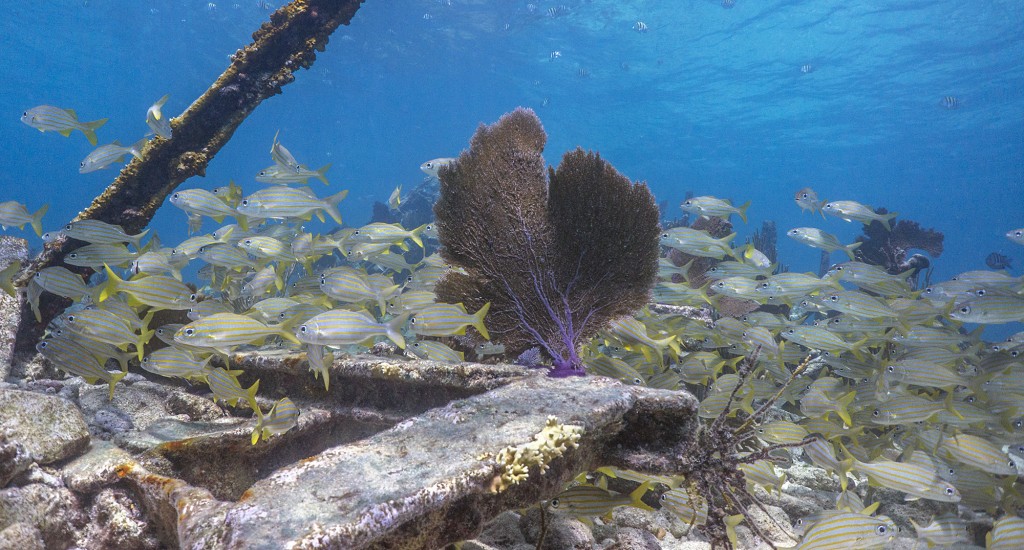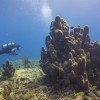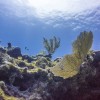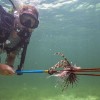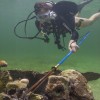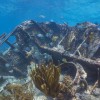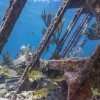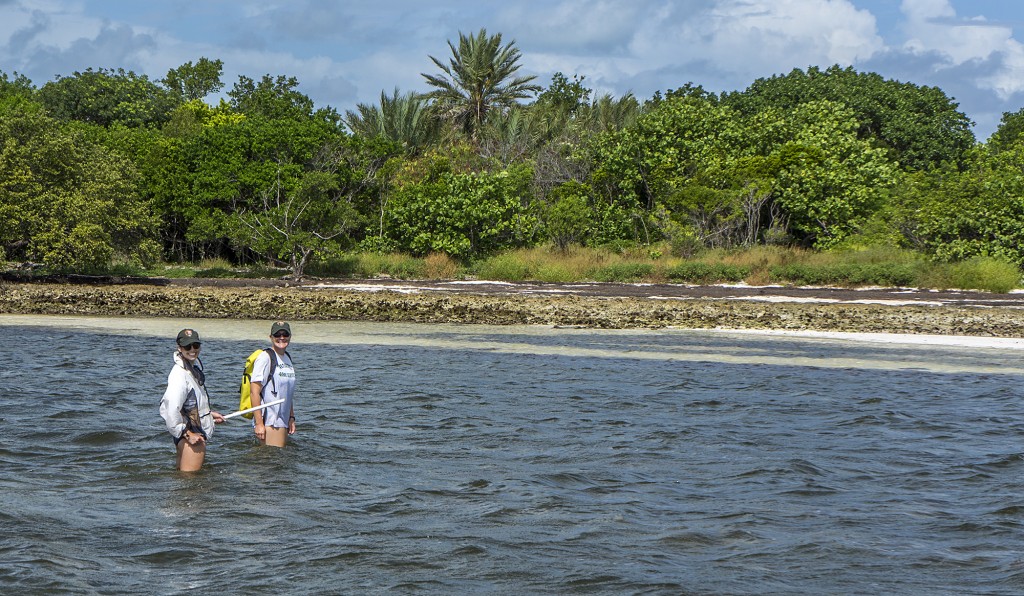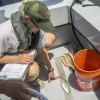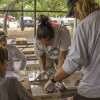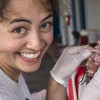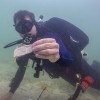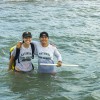The last two weeks in Biscayne National Park have been a great introduction to the variety of underwater cultural and natural resource management projects going on in the National Park Service, as well as the realities of the weather dependency of marine field work.
At the Miami airport I was greeted by a wave of scorching heat and humidity, as well as SRC Survey Archeologist Bert Ho. A group of SRCers are in Biscayne working on archeological projects, and they showed me around park headquarters and introduced me to Chief of Cultural Resources Chuck Lawson, wildlife biologist Vanessa McDonough, and wildlife biologist and Park Dive Officer Shelby Moneysmith, with whom I would be working for the next two weeks. It was great to see familiar SRC faces around the dive locker, and have their expertise and reassurance nearby for the first few days as I bumbled about in typical fashion breaking and losing equipment (the computer I feared I had ruined turned out to be misinterpreting the Denver-South Florida altitude shift as one extremely long, shallow dive, but the high-tech emergency radio that popped out of my BCD my first time out is gone for good). Bert showed me how to use their fancy underwater camera, so I’m hoping to experiment and improve my photography skills throughout this internship. Bert was also kind enough to be my ride for the two weeks, taking me to my CPR/first aid refresher course in Key Largo and introducing me to the delights of strawberry key lime milkshakes at enigmatically named local fruit stand Robert Is Here.
I spent my days in Biscayne working primarily with Shelby and the resource management team, and one of their main projects is removing invasive lionfish. Native to the Indo-Pacific region, these striking fish with fluttering, sail-like fins and venomous spines have become a huge problem in tropical Caribbean ecosystems, considered one of the worst marine invasions in history. Lionfish devastate native reef biodiversity with efficient hunting, relentless reproduction, and insatiable appetites. Such successful predators are they that scientists have discovered that some lionfish populations, truly assimilating to their new American environments, are becoming obese Their predilection for hiding in deep, complex habitats makes them difficult to fish with nets or trawls, and the best way to remove them seems to be individual spearfishing. Biscayne National Park employs two interns, Ana Zangroniz and Kristian Rogers, specifically devoted to this purpose, and my first day out I went with them to do my part to stop this deadly invader.
After an exhilarating boat ride to our assigned lionfish point, Ana, Kristian, veteran lionfish intern Ryan Fura, and I dropped into the clear, warm water of Biscayne Bay, spears in hand. The spear has three sharp metal points on one end and a large rubber band on the other, and is operated by stretching the rubber band near the sharp end, aiming, and releasing. Within a few minutes, Ryan found two fairly large lionfish underneath a coral ledge, and invited me to take a shot. They are sedate and unruffled, and allow a close approach with the spear; nonetheless it took me a few tries to nab each one. It was slightly unsettling to note how much I enjoyed killing these beautiful fish, but I’m chalking it up to my strong conservationist values. Unfortunately, the team works with randomly selected sites for the sake of science, and most had sandy bottoms rather than lionfish-filled nooks and crannies, hardly conducive to honing my killer skills: I only got two more in the next three days. The lack of lionfish did give me the chance to experiment with the camera—I’ve included some pictures below.
I also walked turtle beaches almost every day, patrolling for signs of nesting activity. Any nests are covered with a metal screen to prevent raccoons from digging for the eggs; the nests are monitored for predation and the screens are removed near hatching time. I worked variously with Shelby, Ryan, sea turtle intern Amanda Tinoco, and amazing volunteers Suzy and George Pappas. In addition to their day jobs, the Pappases have started an NGO called the Coastal Cleanup Coalition. During their free mornings and weekends, they come out and clean up trash from the beaches, and have led alternative spring break trips to the park, removing tons of garbage from the beaches each spring. It’s been documented that if turtles encounter trash or debris on a beach, they will turn around without nesting, called a false crawl. Lugging their ungainly bodies over these sharp rocky beaches without nesting is a huge waste of turtles’ energy and resources, so removing debris from nesting beaches is a crucial task. It was so inspiring to see George and Suzy selflessly battle heat and horseflies every week to clean the beaches—the world needs many more of them! Luckily, their hard work appears to be paying off. With cleaner beaches, predation deterrent efforts, and invasive plant removal, the resource management team has already recorded thirteen nests (including a rare green sea turtle nest in addition to the usual loggerheads), whereas last year there were only six all season, all of which were predated.
After one morning of beach walks, Shelby, her volunteering neighbor Bradford, and I had a chance to accompany law enforcement officers Evan Pickford and Joe Dollemolle on creel surveys, documenting recreational fishing (A creel is a type of fishing net, so creel surveys refer to studies of fish catches). We zipped through mangrove-lined channels in search of fishermen, and measured any fish they caught both to enforce regulations and collect population data. Under the watchful eye of the law enforcement officers, everyone was extremely friendly and compliant, and apart from a few warnings about having enough life preservers on the boat people were following regulations. Protecting marine environments is ineffective without enforcement, so it was wonderful to see the law enforcement officers patrolling the park and fishermen responding to regulations.
Unfortunately, at the beginning of the second week, unseasonably high winds picked up, making diving inadvisable. This gave me a taste of park office life, and the opportunity to process our lionfish, recording location caught, length, mass, and gut contents. These lionfish, fortunately, weren’t overweight, and the most we found in their stomachs was a few small fish. The wind was a blessing for discouraging mosquitoes, and for diluting the lionfish innards smell as the afternoon wore on.
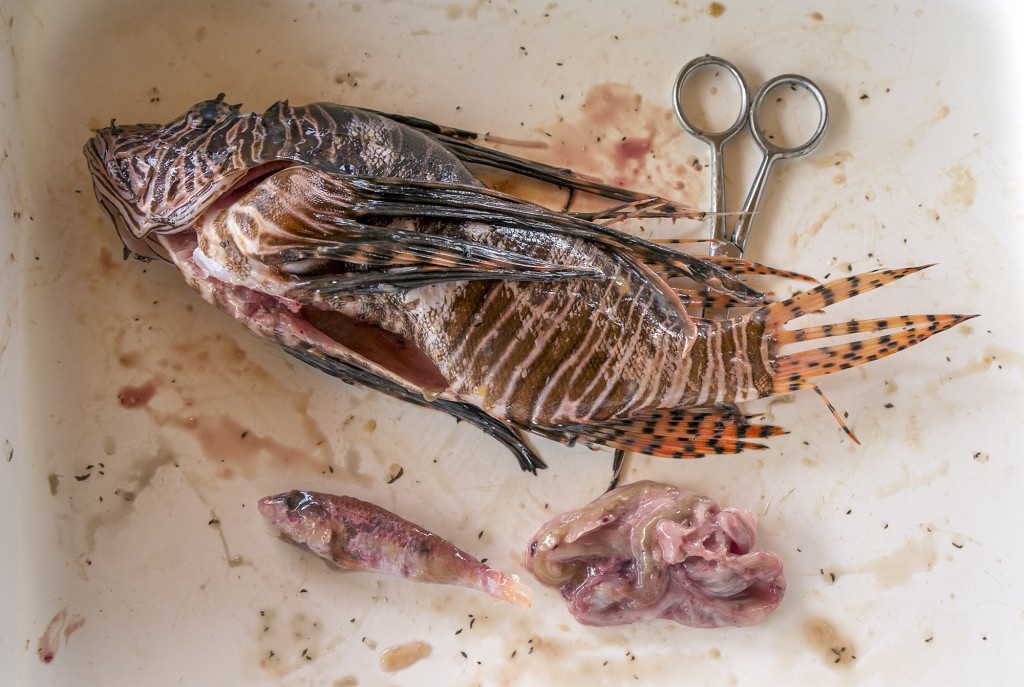
This lionfish had snacked on a small wrasse before it fell victim to the unstoppable lionfish intern team.
That Wednesday, I hopped on the boat with the valiant SRC team, which was headed out to dive despite 20+ knot winds. After passing up some sites that were clearly too rough and aborting a dive due to poor visibility and rough conditions, we jumped in on the English China wreck, which is littered with shards of ornate ceramics, despite having been looted by treasure hunters in the past. Bureau of Ocean Energy Management (BOEM) archeologist Willy Hoffman and I poked around the pottery shards and old timber while Bert and SRC archeologist John Bright laid a GPS marker. Onboard the boat, the team deployed “Rocky” the magnetometer, which measures anomalies in the earth’s magnetic field. Anomalies indicate the presence of something like iron from a shipwreck, so magnetometry data can be used to locate sunken artifacts and map their distribution. The park must constantly monitor this and other wrecks not only to document any naturally occurring changes to the site, but also to be sure that visors aren’t causing damage or destruction, especially from looting. Winds were too high the next day to go out at all, so we celebrated Independence Day with data processing and a delicious Cuban dinner.
On my last day of fieldwork, winds still blowing above 20 knots, Amanda, Ryan and I braved the elements to patrol the turtle beaches once again, and were rewarded with a nest! Amanda recognized the uprooted vegetation and flattened sand patch as nesting activity and we dug around it to confirm. Just when I was certain we wouldn’t find anything we uncovered the tops of the leathery, golf ball sized eggs. We reburied them, placed the protective screens over the nest area, and marked the nest with the date. I hope to hear reports of hatchlings in a few months!
My stay at Biscayne ended with a barbecue at Chuck’s house, with wonderful company, delicious food, and rousing games of legos and hopscotch with Charlie, Chuck’s six-year-old daughter and my new BFF. Thanks so much to Chuck and his wife Ariana for hosting, as well as Shelby, Vanessa, and everyone at Biscayne National Park for working with me and setting my internship off to a fun and exciting start! Now laden with the giant camera case in addition to all my dive gear, I’m off to the Virgin Islands for two weeks of fish and coral surveys.

